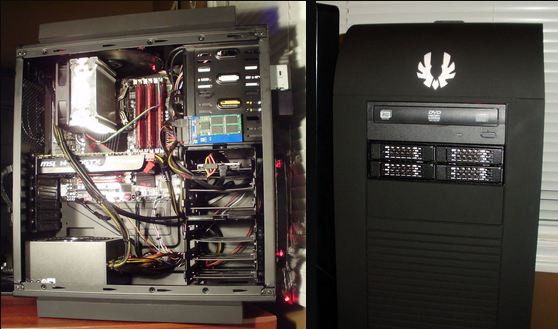TEST BENCH CONFIGURATION
| Motherboard | Asus Rampage III Gene SATA 6Gb/s USB3 |
| CPU | Intel i7-930 CPU@2.80Ghz (OC’d to 3.2Ghz) |
| RAM | 6Gb G.Skill 1600 Triple Channel |
| Graphics | MSI N460GTX DDR5 768MB |
| Power Supply | OCZ ModXStream-Pro 600w |
| CPU Cooler | Cooler Master Hyper 212+ |
| OS | Windows 7 64 Bit Ultimate |
| Wifi | Belkin Surf & Share Wireless USB Adapter |
| Monitor | Dell E228WFP 22″ Flat Panel |
| Desktop Case | BitFenix Survivor Mid-Tower ATX Gaming Case (x) |
| Front Loading Mobile SSD Rack | Icy Dock SSD 4 x 2.5″ Mobile Rack (x) |
SOFTWARE
Software utilized for the review included Crystal Disk Mark, HDTune Pro, ATTO Benchmark, HDTach, along with FutureMark PCMark Vantage. All tests are conducted in Windows 7 safe mode, wherever possible, as this gives the truest result for evaluation purposes; the sole exception being PCMark Vantage which would not function in safe mode. Where the opportunity exists, tests are repeated to ensure accuracy and consistency of results.
DISK INFORMATION – CRYSTAL DISK INFO
BENCHMARKS
1. Crystal Disk Mark Ver. 3.0
The ATTO benchmark was a bit unexpected because the Crystal Disk Mark results in ‘0Fill’ mode usually stand side by side with the ATTO Benchmark, however, in this case we see that ATTO has pulled the high sequential read and write scores up to 280MB/s and 206MB/s respectively which is nice to see. In the normal course of testing SSDs, the best method is to use random data during the Crystal DiskMark test as it mimics normal activity closely. Random data testing does not work well with SandForce controlled SSDs as they use compression in storage and this leaves an unfair and skewed appearance in viewing these scores beside that of other drives. We find that the best software available for side-by-side comparison is PCMark Vantage x64 as the synthetic tests are based on everyday activities of the common user.
PG1 – PHYSICAL DESCRIPTION & SPECIFICATIONS
PG2 – TEST BENCH & CRYSTAL/ATTO BENCHMARKS
PG3 – HDTACH & HDTUNE BENCHMARKS
PG4 – PCMARK VANTAGE & FINAL THOUGHTS
 The SSD Review The Worlds Dedicated SSD Education and Review Resource |
The SSD Review The Worlds Dedicated SSD Education and Review Resource | 

